How to choose linoleum for the kitchen?
When choosing a covering, consider the following recommendations:
- When choosing this product, its hygroscopicity plays an important role.
- The covering should have minimal slip even when wet, be resistant to abrasion and loads.
- When using thin linoleum, to avoid defects and imperfections on the surface, it is necessary to carefully level the base.
- To decorate a small or narrow kitchen, it will be inappropriate to lay a variegated covering. Here it is better to use flooring in light shades with a glossy surface or diagonal pattern.
- It is desirable that the color of the linoleum matches the kitchen set.
- When choosing, you should pay attention to the marking, since the kitchen flooring should have increased antiseptic properties.

The photo shows the interior of a small kitchen with light-colored linoleum on the floor.
Pros and cons of linoleum in the kitchen
The main advantages and disadvantages.

Types of linoleum for floors
By thickness, susceptibility to abrasion and the presence of a protective layer, the coatings are divided into three main classes:
- Commercial. It is made of polyvinyl chloride and most often has a single-layer structure without an additional backing. The commercial type is hygienic, fireproof and has a powerful protective layer, which can significantly increase the strength and durability of the product.
- Semi-commercial. It is considered quite wear-resistant. It includes a felt and synthetic base, due to which this coating better retains heat in the room.
- Household. Universal, moisture-resistant, elastic, easy to care for, has a wide range of colors and has a foam and felt base.
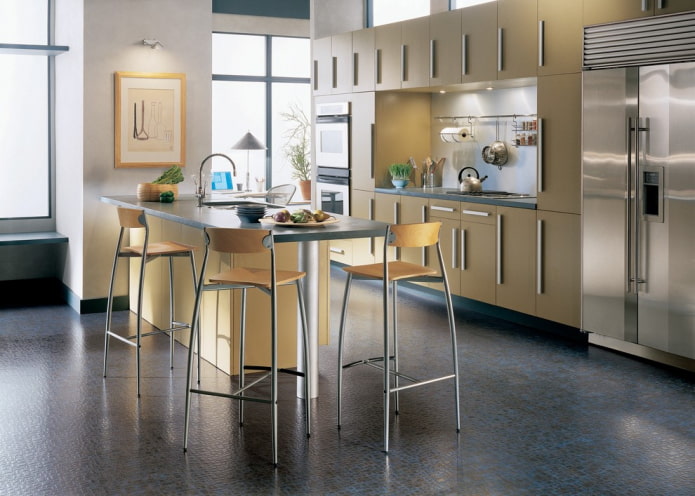
The photo shows semi-commercial blue linoleum on the floor in the kitchen interior.
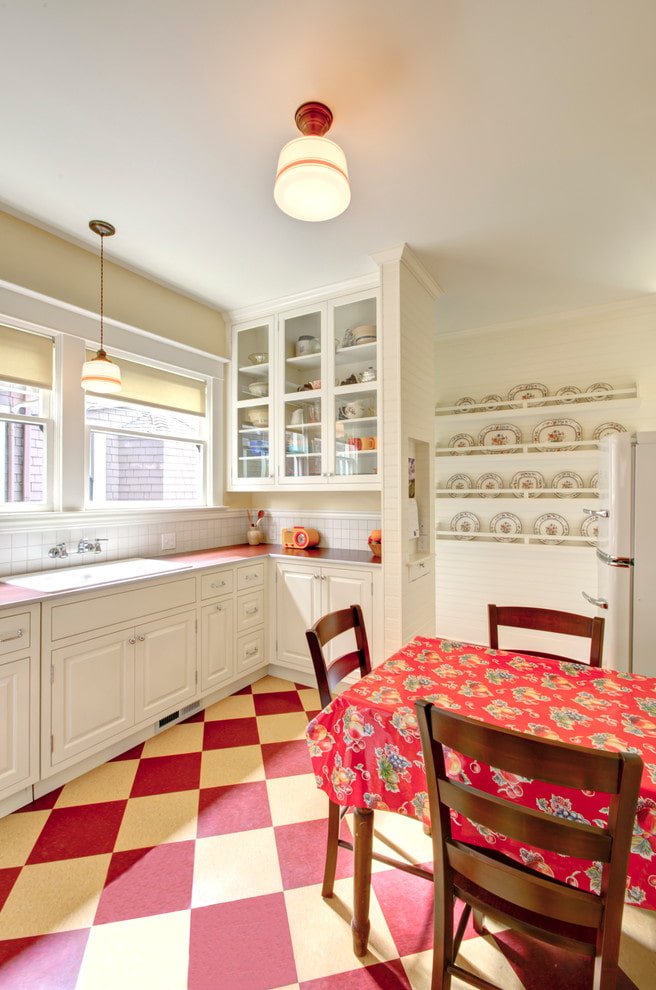
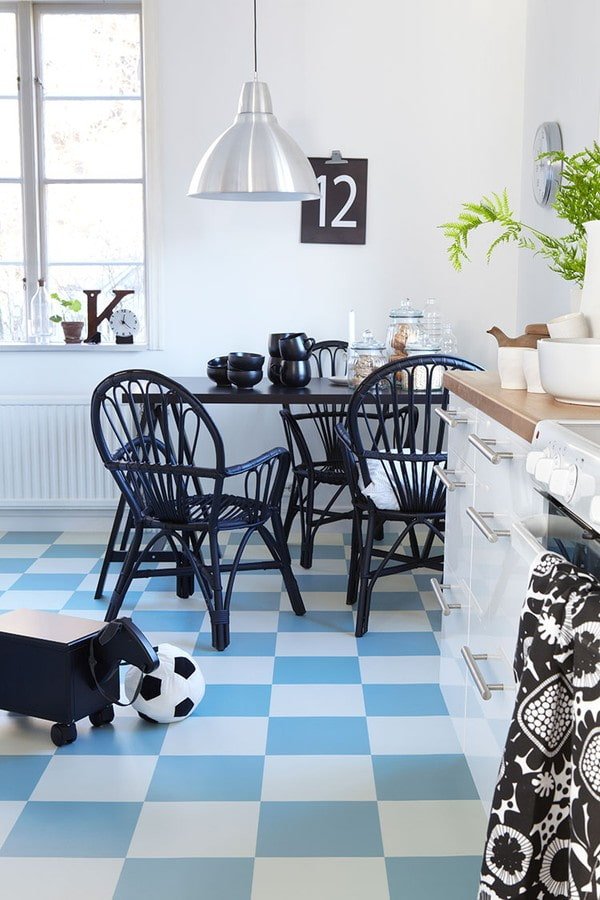
Recommendations for choosing a material
Natural ecological linoleum contains lime powder, cork conglomerate, linseed oil, resin and natural coloring pigments, which are applied to a jute and linen base.
Among the artificial ones, there are glyphthalic, rubber, collodion types, as well as hypoallergenic and safe PVC coating, which has high moisture resistance, strength, elasticity, resistance to mechanical stress and a huge number of colors and patterns. It can be multi-layer heterogeneous or consisting of one layer – homogeneous.
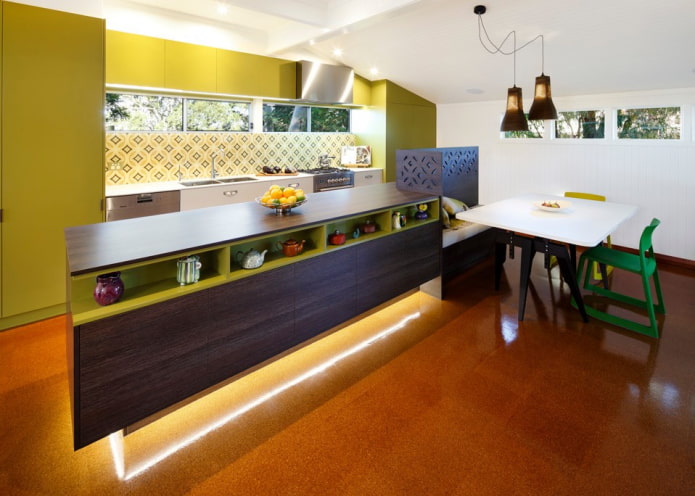
The photo shows the kitchen interior with red PVC linoleum flooring.

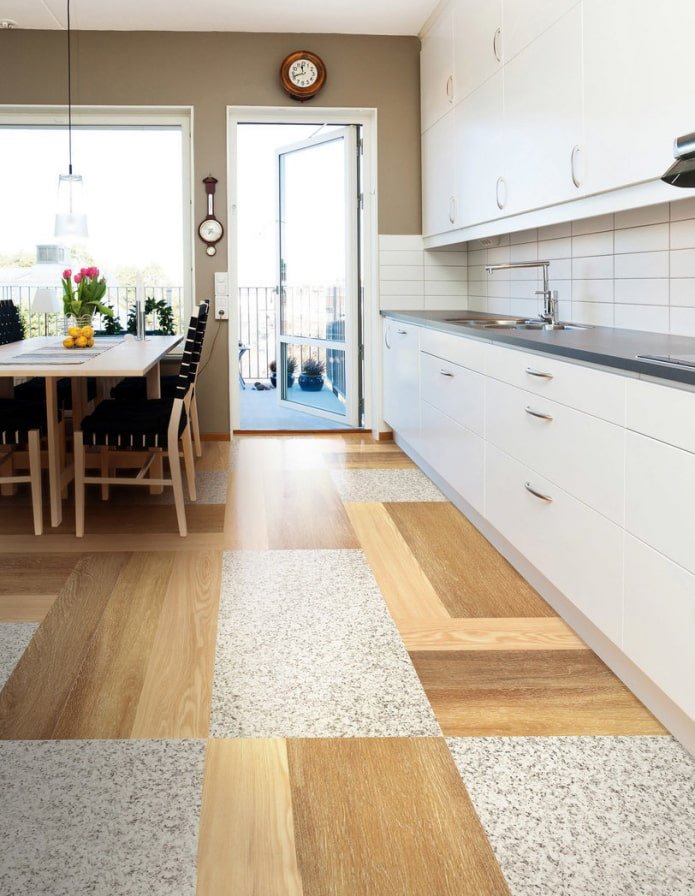
The main advantage of liquid self-leveling linoleum is a smooth and even surface without seams. This material is made of high-quality processed polyurethane and epoxy resin.
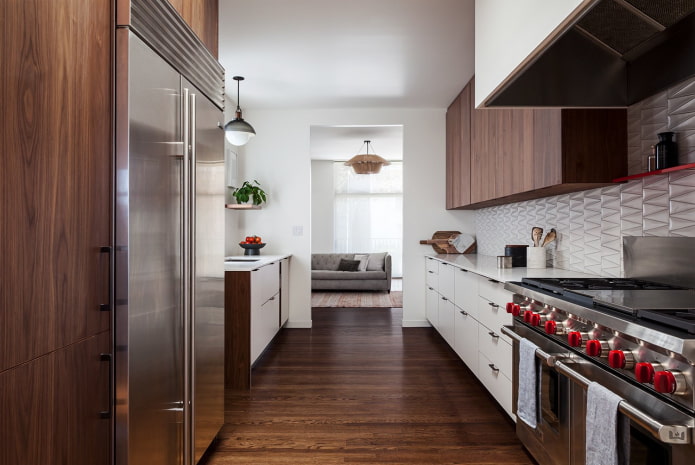
How to choose the color of kitchen linoleum?
Choosing a color scheme for the kitchen flooring also requires a competent approach.
Black
Is a sign of respectability and undoubtedly becomes the main detail of the entire room. Black luxurious flooring, especially in combination with light walls and high-quality lighting, will form a laconic and harmonious design.
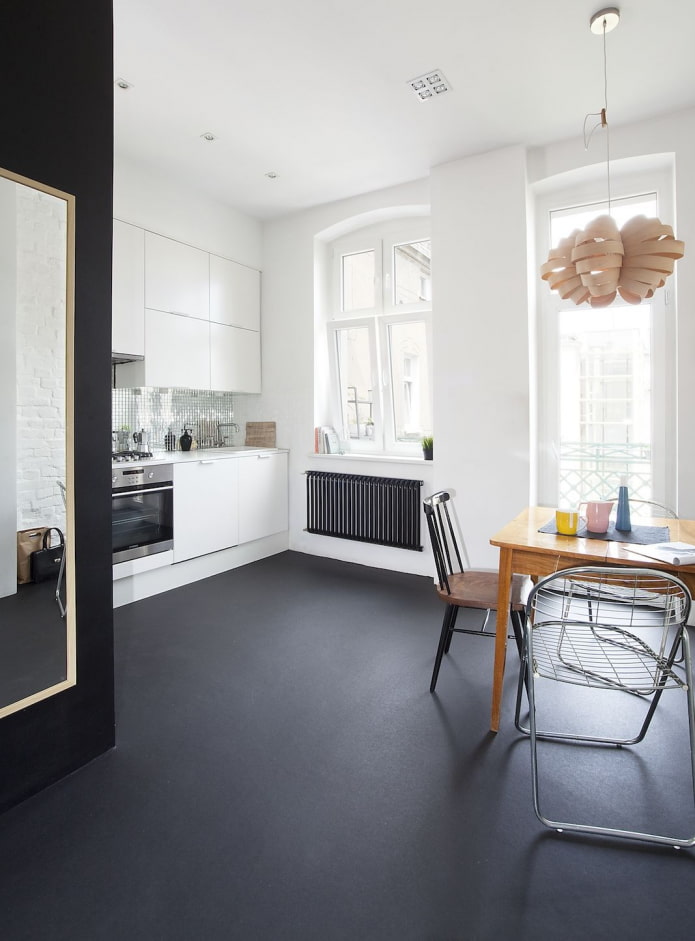
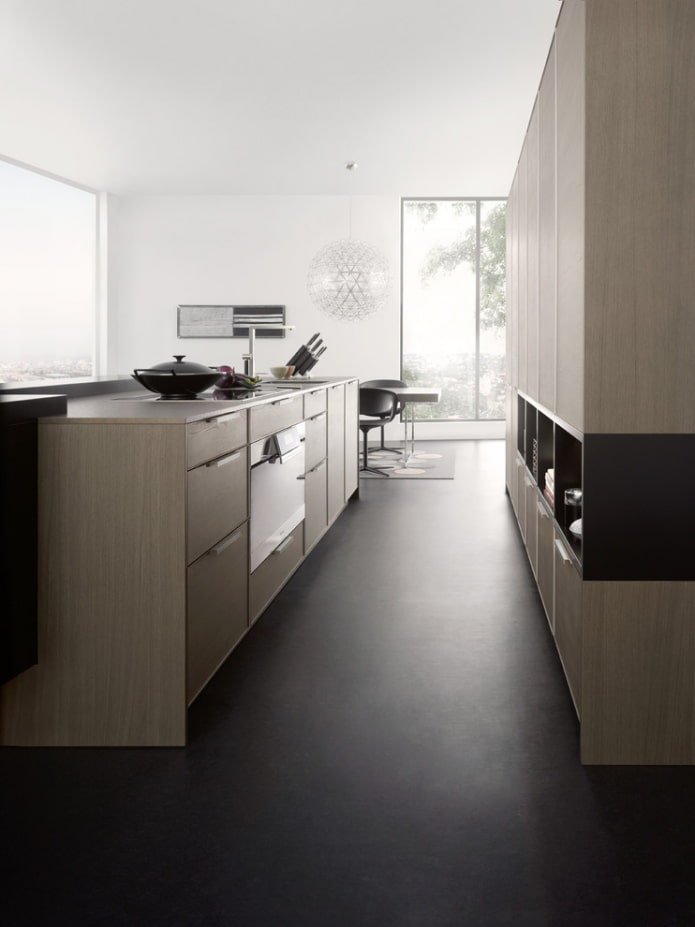
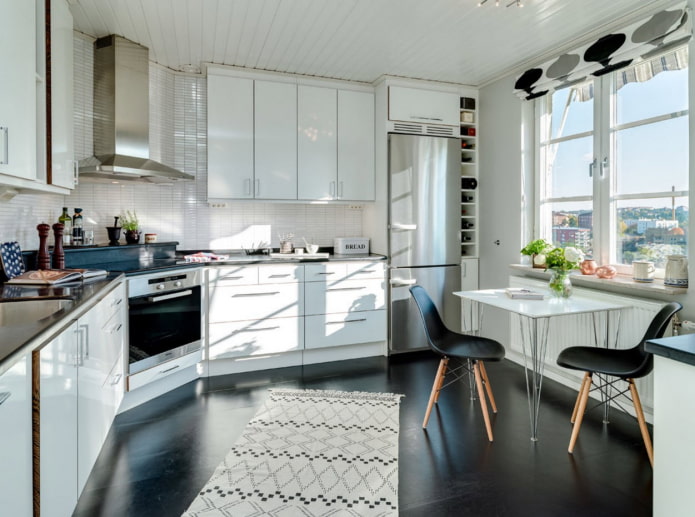
The photo shows dark black linoleum in a kitchen done in Scandinavian style.
White
It will give a feeling of lightness and purity, visually expand the spatial boundaries and draw even more attention to the furniture.
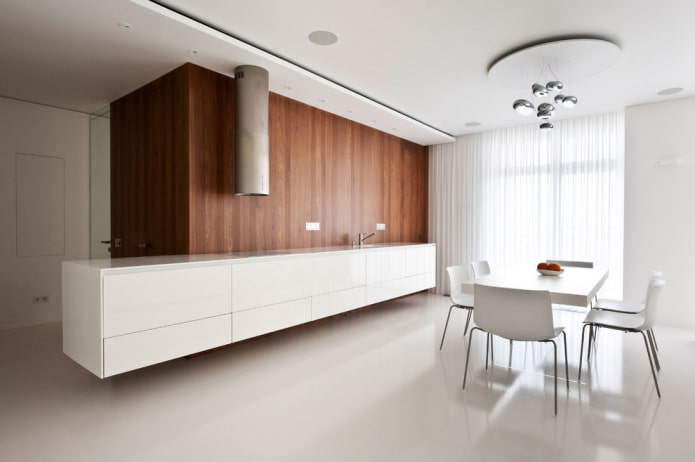
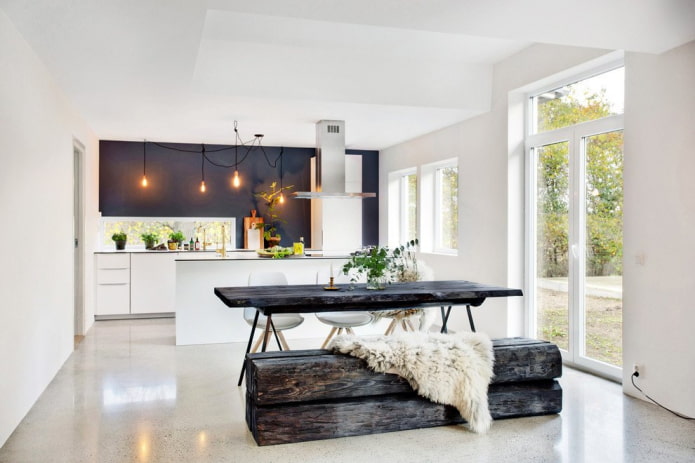
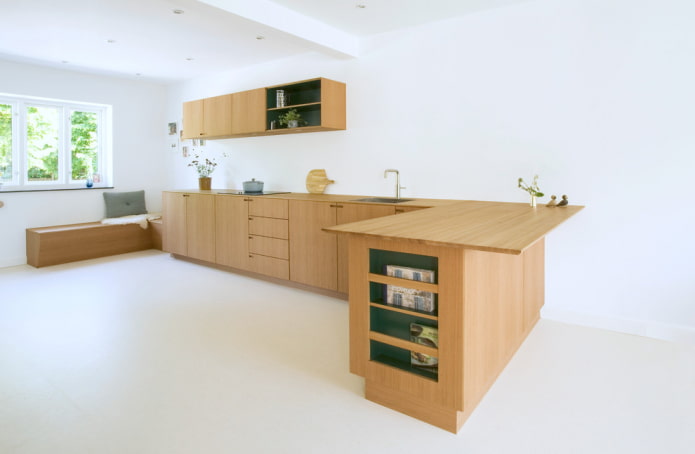
Brown
It has a stylish, solid and luxurious look and is a classic solution for giving the interior a dignified and majestic image.

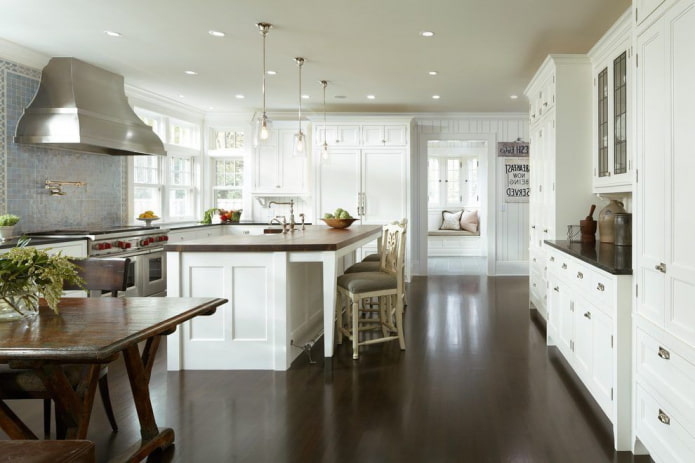
Green
A natural grassy green shade will give the atmosphere a touch of freshness and will become the most noticeable, bright and effective decorative room decoration.
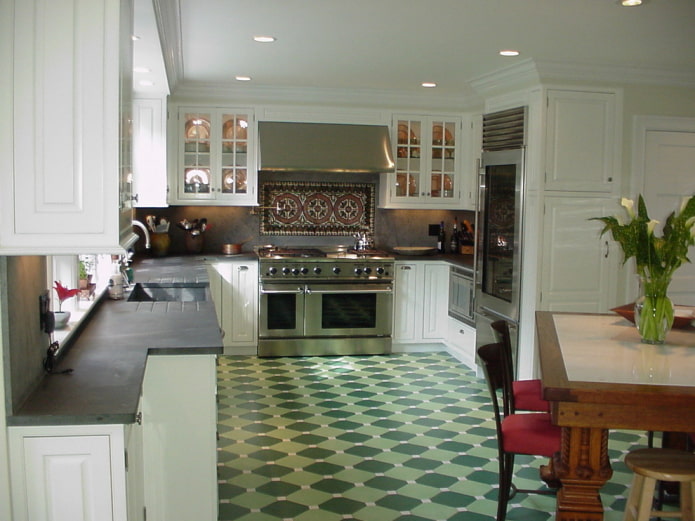
The photo shows the kitchen floor decorated with green linoleum.
Gray
Due to its neutrality, it is considered a fairly common color that always looks very noble and stylish.
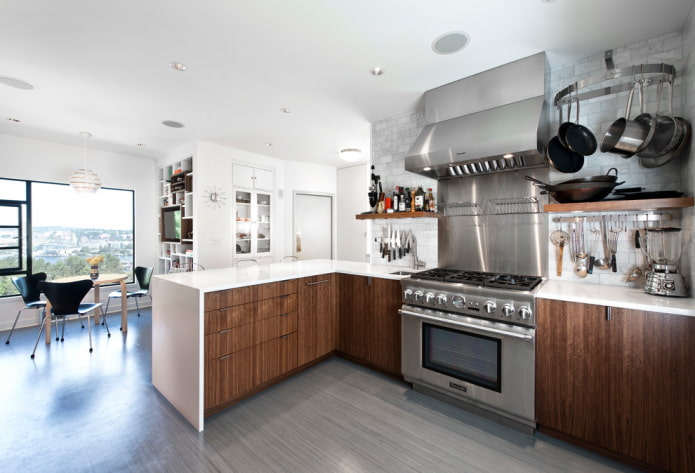
Yellow
It will charge the atmosphere of the kitchen with positive and good mood, and also compensates for the lack of natural light.
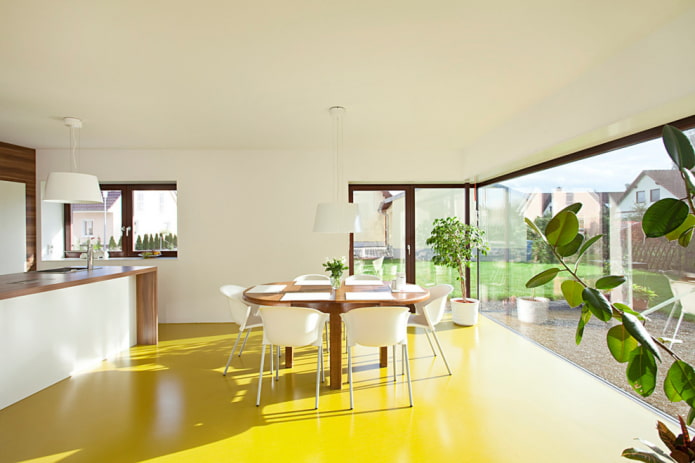
The photo shows a kitchen combined with a dining room with a floor covered with matte yellow linoleum.
Beige
It will give the atmosphere individuality, aristocracy, good taste and will endow the space with warm and positive energy. In addition, if yellowing occurs, it will be less noticeable on a beige coating.
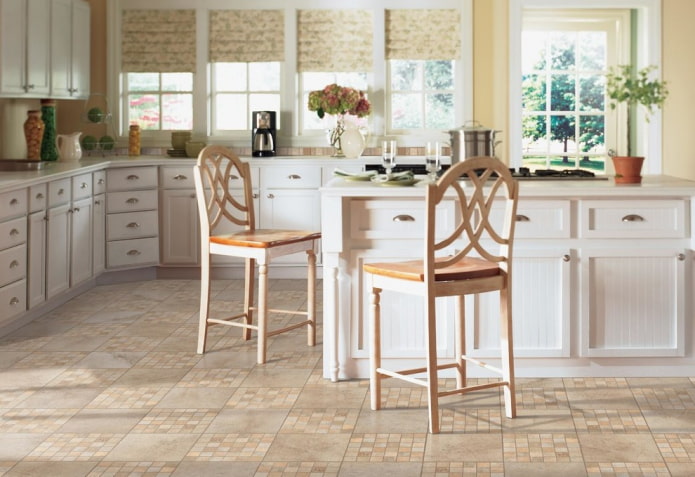
The photo shows light beige linoleum in the interior of a kitchen in the Provence style.
Linoleum design in the interior
Thanks to the variety of designs, you can choose the most suitable design that will ideally complement the overall interior picture.
Linoleum with a tile pattern
It is a fairly popular design solution that allows you to get a coating with a high-quality imitation of the texture of tiles, depressions and inter-tiles at little cost. seams.
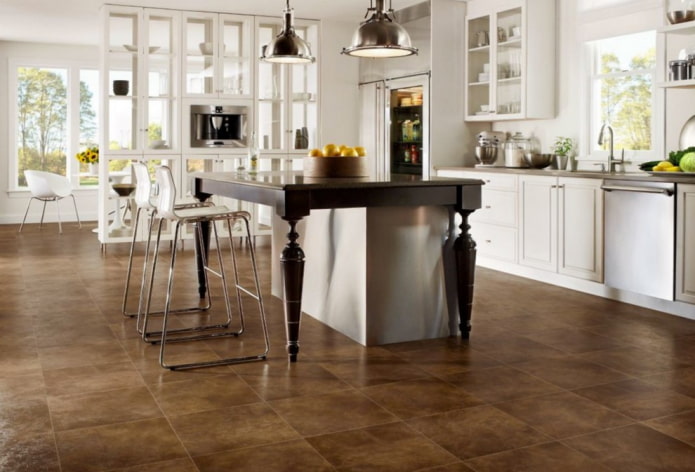
Imitation of laminate
Linoleum under the laminate, parquet or board, has a very reliable appearance, is distinguished by the richness of visual effects and a variety of color shades from light wood to dark wenge, due to which it is possible to create a calm and cozy interior. When choosing this product, it is important to consider the correct direction of the parquet or laminate strips and color, depending on the features of the kitchen.
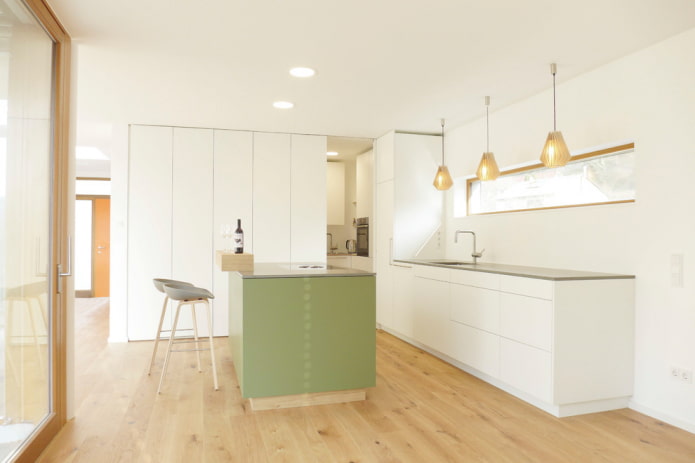
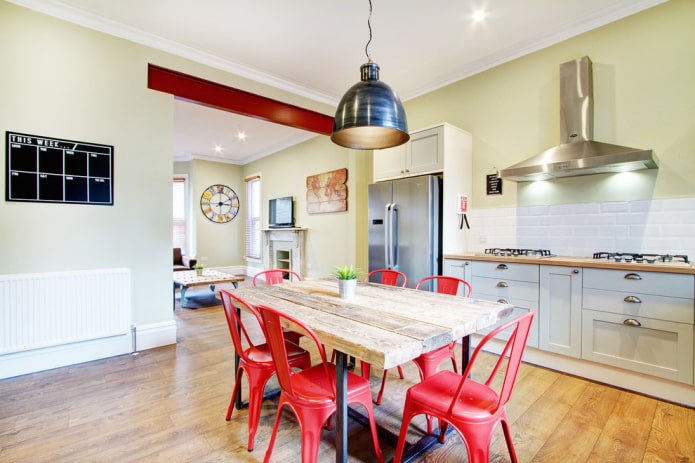
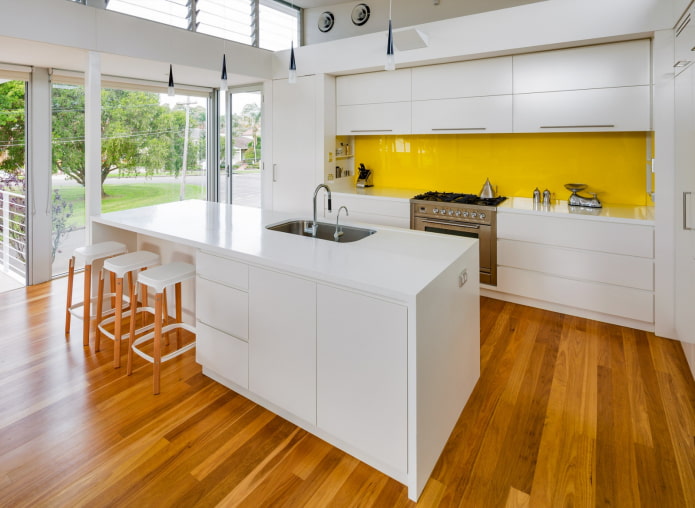
The photo shows the interior of a modern kitchen with linoleum imitation of laminate board.
Combination floor in the kitchen
Linoleum goes well with other finishing materials, such as tiles, porcelain stoneware, laminate or parquet. In this way, it is possible to create a certain interior composition, focus attention on the necessary spatial areas and visually zone the kitchen. You can also add a special individuality to the environment by combining linoleum of different colors, textures or patterns.
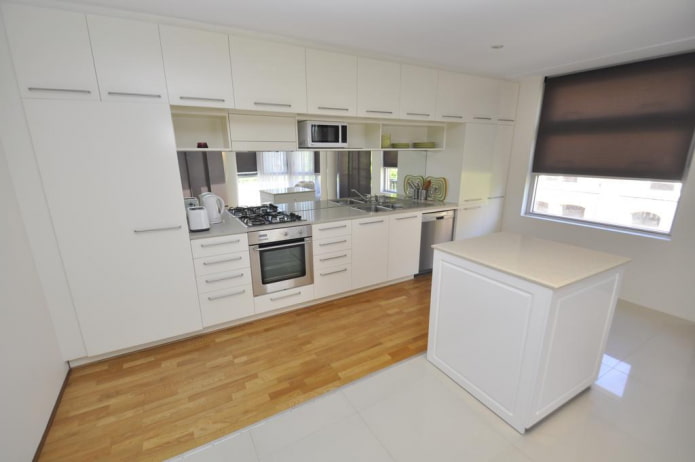
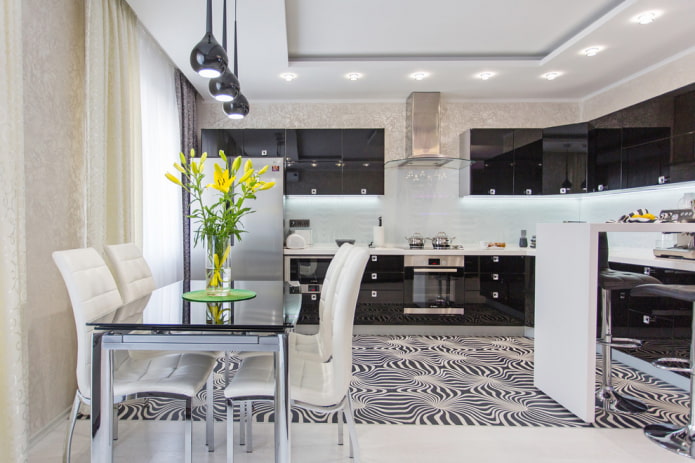
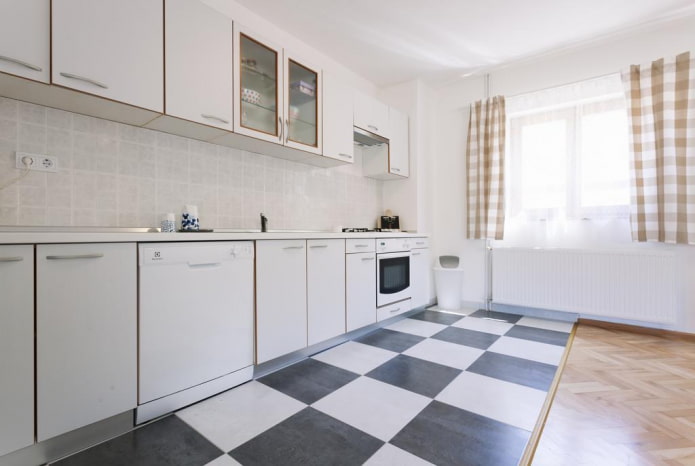
Under marble
It will add originality and exoticism to the design, will further emphasize the style and unique interior design, and will also become an independent decoration that creates a magnificent and presentable atmosphere.

The photo shows linoleum flooring with imitation of light marble in the kitchen interior.
Imitation of grass
It looks like natural grass, which allows you to create a beautiful, natural and maximally natural atmosphere in the space.
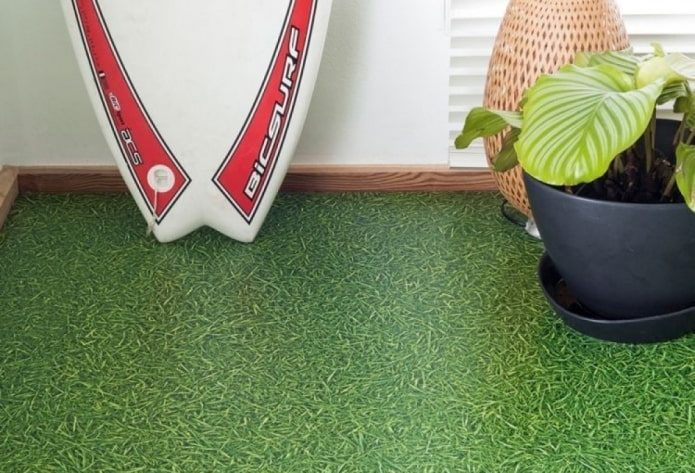
Geometric patterns
Fashionable prints with zigzags, squares, ovals, circles, diamonds, checkered or striped coverings can not only set a certain character for the kitchen, but also affect its spatial perception in different ways.
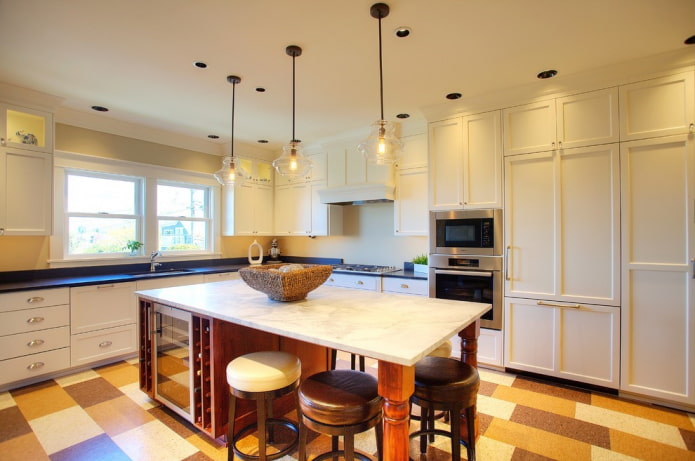
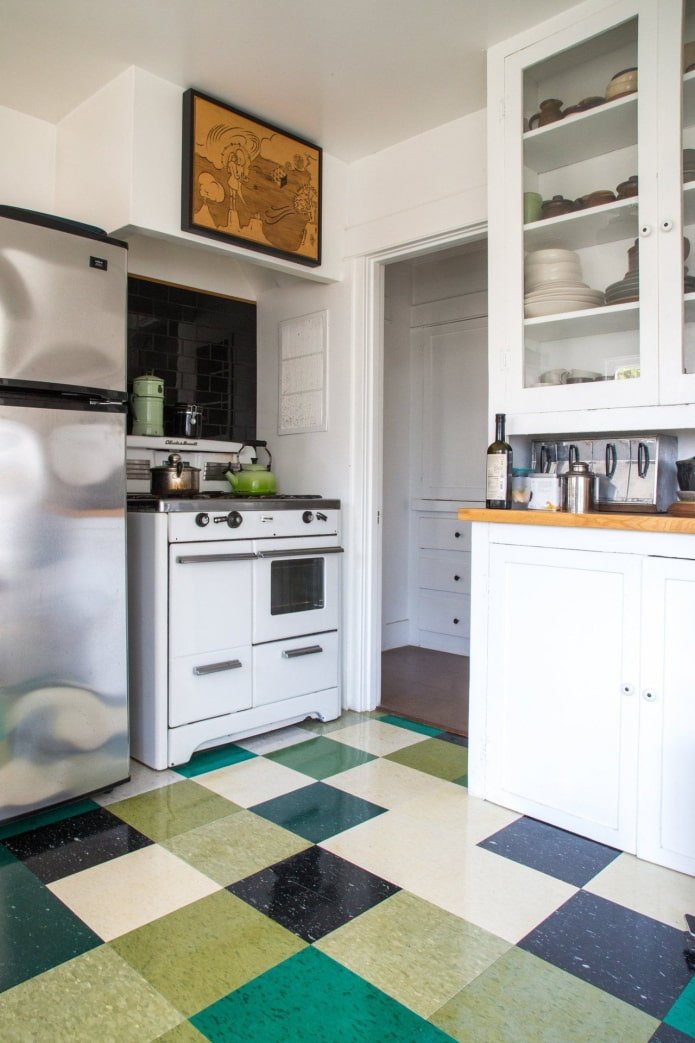
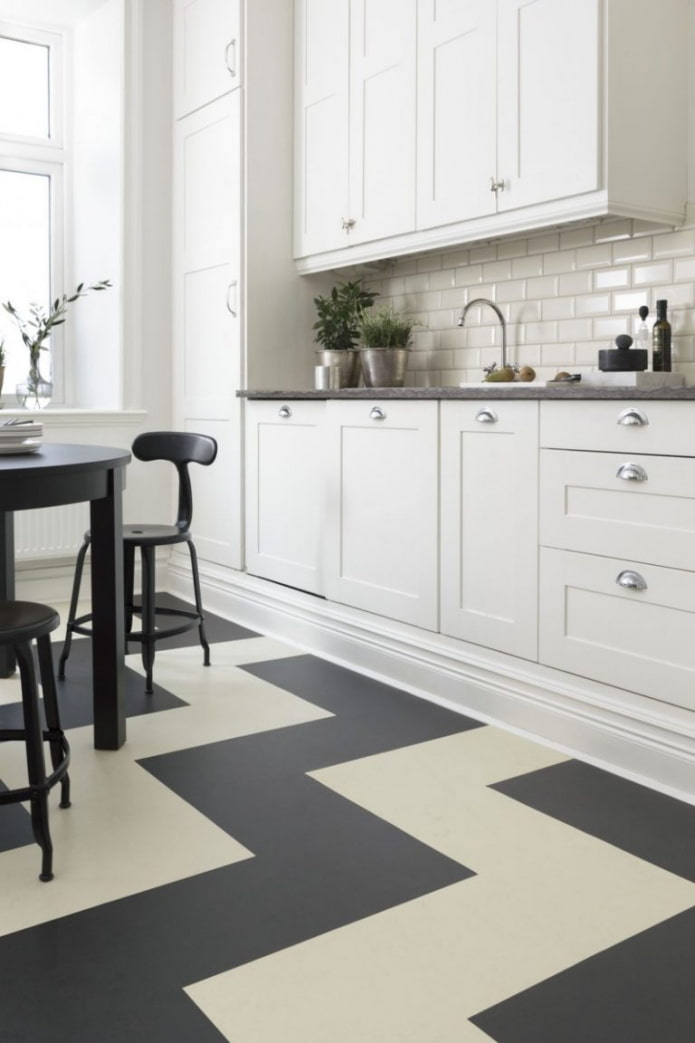
Geometric or abstract figures can set the atmosphere both rhythm and dynamics, and calm restraint and tranquility. Large patterns help to create the necessary accents in the room, and small patterns help to add spaciousness and airiness to the space.
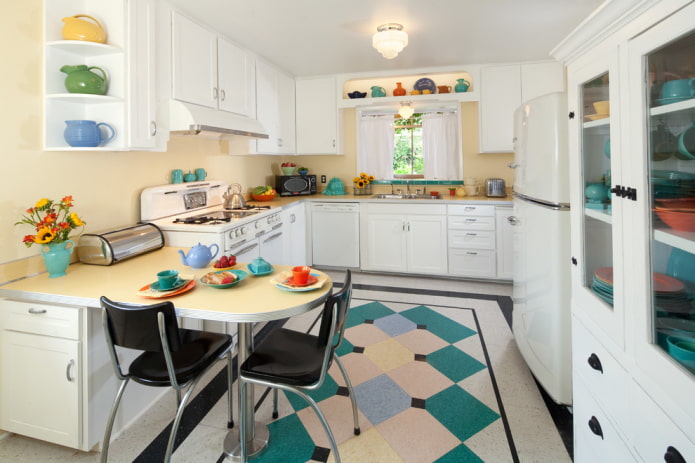
The photo shows the kitchen floor decorated with linoleum with a geometric pattern in the form of multi-colored diamonds.
Patterns and prints
Various patterns, ornaments and unusual abstraction allow you to dilute the strict and monochromatic kitchen design and fill the atmosphere with a certain mystery and coziness. Linoleum with 3D prints has the illusion of three-dimensional space and realistically conveys the volume of the pattern.
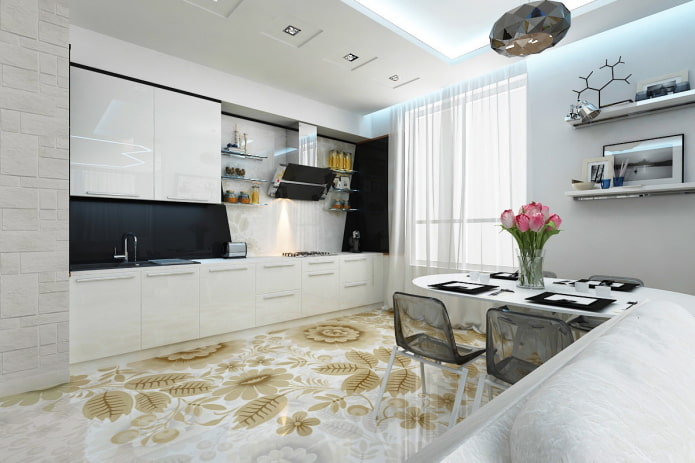

Options for finishing walls with linoleum
For finishing walls or an apron, a product made of polyurethane polymer is used, which, due to its high elasticity, makes it possible to cover the most various surfaces, angles, curves and projections. Wall linoleum is considered a very promising and creative way of decoration and can imitate natural fabric, stonework, leather, tiles and other materials.
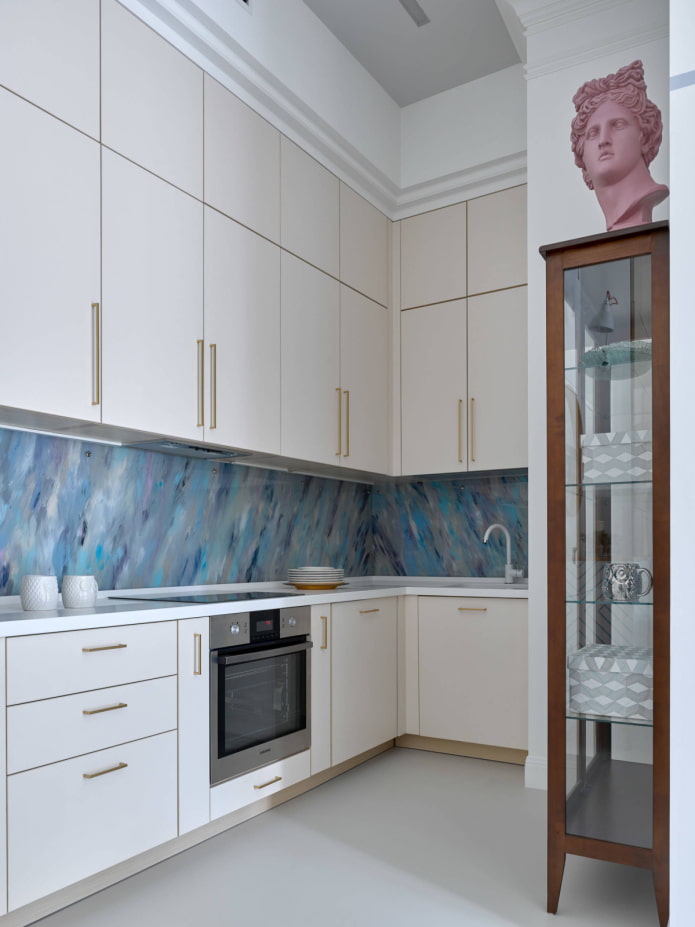
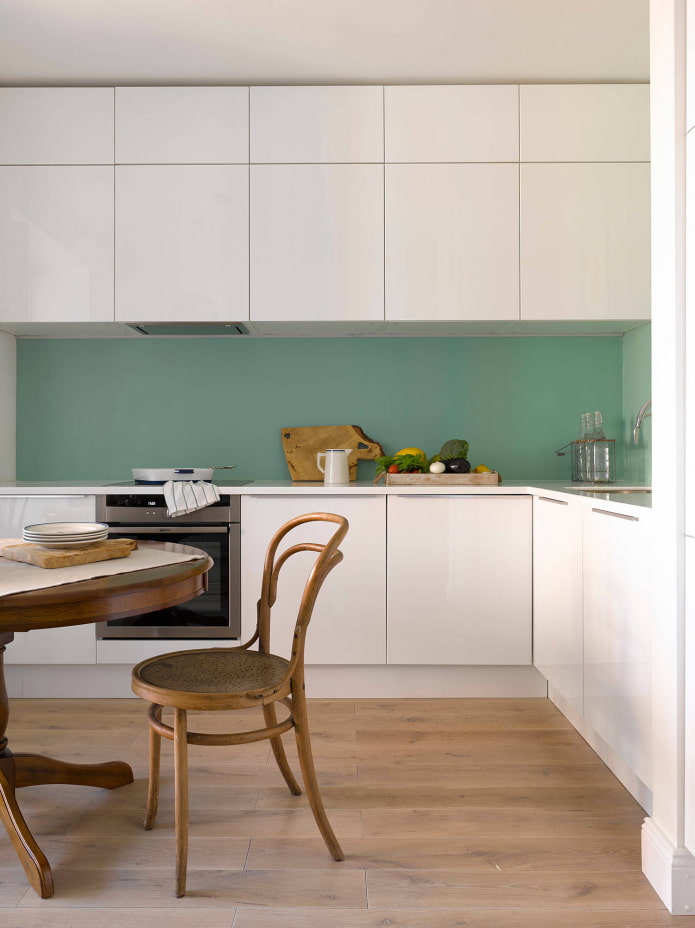
What is better to choose for the kitchen: linoleum, tiles or laminate?
Linoleum is very often used for kitchen decoration, but many also prefer tiles or laminate as cladding. Each type of coating has its own advantages and disadvantages.
It is durable, depending on the type, it can last more 15 years.
The felt-based coating absorbs noise well.
It can differ in various imitations, for example, wood texture, stone and others.
It has a lower price.
This coating is much easier to lay and dismantle.
Compared to laminate and tiles, linoleum is a more optimal option for the kitchen.


Now reading:
- Comprehensive Guide to Pre-Owned Nissan X-Trail Vehicles
- 12 original ways to decorate your apartment for the New Year, it’s worth getting down to business!
- Essential Items for Every Bathroom.
- Doors for rooms in an apartment: choice of materials, shades and photo gallery.
- Interior Mirror Design Ideas: Over 50 Original Photos